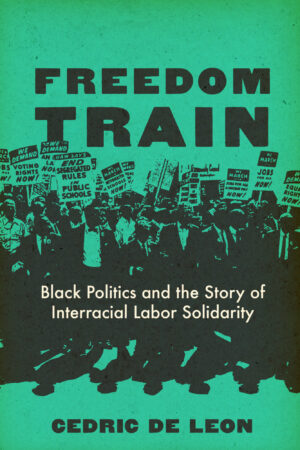How Black Workers Drove Interracial Labor Solidarity
By Cedric de Leon, author of Freedom Train: Black Politics and the Story of Interracial Labor Solidarity
The elusive promise of interracial solidarity is an age-old question, one made all the more urgent in the current political climate. Can Black and white workers stick together against their bosses? Might their solidarity scale up to a multiracial working class movement, powerful enough to defy the capitalist system?
In the sociology of labor and labor movements, the debate turns on a similar question: are American unions exclusionary toward, or protective of, Black labor? Some highlight cases in which white workers and labor leaders have engaged in racist behavior. Others point out that progressive unions have welcomed Black workers into their ranks and even elected them to positions of power.

Although both camps offer important lessons for anyone studying or building social movements, this way of framing the question is problematic for two reasons. First, white people are the main protagonists in these stories. Black people, conversely, are the passive victims or beneficiaries of white people. Second, most sociologists look for interracial solidarity in unions, even though for much of U.S. labor history, Black people were unable to join unions. The result is that Black workers show up as minor players in their own history. We know much less about instances of interracial solidarity in which Black people played the leading role.
In my new book, Freedom Train: Black Politics and the Story of Interracial Labor Solidarity, I urge scholars and labor activists to ask a different question: what conditions within the Black community enabled interracial labor solidarity? Once we look at the encounter from the Black worker’s point of view — that is from the “subaltern” standpoint — the story of interracial solidarity looks very different. The archives reveal that white people were hardly the architects of a racially unified labor movement, but were instead inconsistent in their support of, if not hostile to, that vision. Archival data reveal, too, that Black workers had to continually push for their own inclusion even in unions accounted progressive for their time.
What lessons do we learn about the dynamics of interracial solidarity when we start with the lived experience of Black people?
—Cedric de Leon
Moreover, the energy that propelled the struggle for interracial solidarity was the conflict and consensus among competing factions in Black civil society. This is what I mean by “Black Politics.” The Centrist faction, led by A. Philip Randolph, worked internally within the bureaucracy of the American Federation of Labor (AFL) to win membership and affiliation for Black workers in international unions. The Left faction, led by successive cadres like Cyril Briggs, Thelma Dale, and Vicki Garvin, were suspicious of the AFL’s apparent racism and class collaboration and favored militant direct action, mass mobilization, and open conflict with capital. This factional struggle in the Black community, while tense and often painful, led to tactical innovations, such as marches in the nation’s capital and the organization of sectors like steel, auto, tobacco, and meatpacking where Black workers were disproportionately concentrated.
What lessons do we learn about the dynamics of interracial solidarity when we start with the lived experience of Black people?
One lesson is that those who already benefitted from unions were not the vanguard of that struggle. White workers were just as likely to oppose integrated unions as they were to support them. Instead, subaltern groups — those whom the labor movement excluded — were the most consistent champions of desegregation.
Moreover, having being shut out of official union channels, Black workers employed alternative organizational forms to achieve integration. I call these “independent Black labor organizations.”
Next, Black women played a pivotal role in integrating unions and the workplace. They were key leaders in every major independent Black labor organization of the twentieth century and insisted, sometimes against the objection of their male counterparts, that gender equity be an organizational priority.
Lastly, the fight for interracial solidarity was not a straightforward story of unified collective struggle. It was instead a messy story of disagreement, intrigue, and marriages of convenience. Nevertheless, it was precisely the conflict and consensus among factions in Black civil society that gave rise to new tactics. These tactics, in turn, extracted deep concessions from the state and capital, perhaps most famously in the 1963 March on Washington for Jobs and Freedom.
To learn more about Freedom Train, listen to my interview with Steven Pitts, co-founder of the National Black Worker Center and former host of the podcast, “Black Work Talk.”
